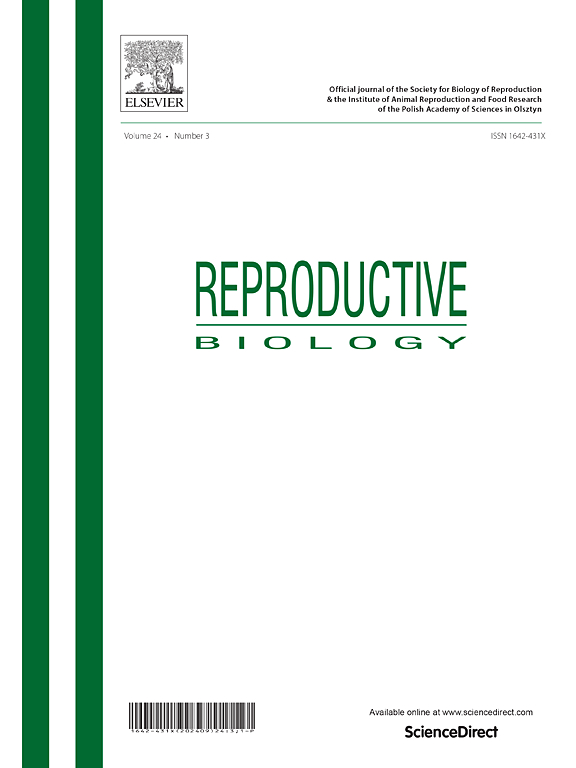Trps1靶向Scarb1调节小鼠间质细胞中的胆固醇获取
IF 2.5
3区 生物学
Q3 REPRODUCTIVE BIOLOGY
引用次数: 0
摘要
大约7 %的男性患有不育症,占所有不育症病例的40 %-50 %,睾丸激素水平低与男性不育症密切相关。我们之前的研究表明,转录抑制因子GATA结合1 (Trps1)可以抑制间质细胞的睾酮合成。为了阐明Trps1在间质细胞中调控睾酮合成的分子机制,本研究通过rna测序对Trps1敲低后的差异表达基因(DEGs)进行了研究。利用京都基因与基因组百科全书(KEGG)富集分析和基因本体(GO)分析来研究与Trps1相关的途径。采用基因沉默技术、Real-Time PCR和Western blot对deg进行验证。此外,进一步观察睾酮和细胞胆固醇含量。我们发现DEGs的氧化石墨烯分析与“胆固醇代谢”相关。Real-Time PCR和Western blot结果显示,Trps1沉默后,甾体生成因子-1 (Sf-1)和清道夫受体B类成员1 (Scarb1)的表达上调。敲低Sf-1和Scarb1可以恢复Trps1缺乏引起的睾酮和细胞胆固醇水平升高。此外,ChIP-seq和CUT&;Tag-qPCR证实Scarb1的启动子具有SF-1的结合位点。本研究发现TRPS1通过调节Sf-1转录活性调控Scarb1的表达,从而提高间质细胞胆固醇水平,促进睾酮合成。本文章由计算机程序翻译,如有差异,请以英文原文为准。
Trps1 targets Scarb1 to regulate cholesterol acquisition in mouse Leydig cells
Approximately 7 % of men are suffering from infertility, accounting for 40 %-50 % of all cases of all infertility, and low testosterone levels are closely associated with male infertility. Our previous study indicated that transcriptional repressor GATA binding 1 (Trps1) could inhibit testosterone synthesis in Leydig cells. In the present study, to elucidate the molecular mechanism by which Trps1 regulates testosterone synthesis in Leydig cells, differentially expressed genes (DEGs) following Trps1 knockdown was conducted by RNA-sequencing. Kyoto Encyclopedia of Genes and Genomes (KEGG) enrichment analysis and Genes ontology (GO) analysis were utilized to investigate the pathways associated with Trps1. Gene-silencing technology, Real-Time PCR, and Western blot were performed to validate DEGs. In addition, testosterone and cellular cholesterol content were further observed. We found that GO analysis of DEGs associated with “cholesterol metabolism”. Real-Time PCR and Western blot showed that the expression of steroidogenic factor-1 (Sf-1) and scavenger receptor class B, member 1 (Scarb1) were up-regulated after Trps1 silencing. Knockdown of Sf-1 and Scarb1 could revert the elevated testosterone and cellular cholesterol levels caused by Trps1 deficiency. Moreover, ChIP-seq and CUT&Tag-qPCR demonstrated that the promoter of Scarb1 has a binding site for SF-1. The present study revealed that TRPS1 exerts regulatory control over the expression of Scarb1 by modulating Sf-1 transcriptional activity, thereby enhancing cholesterol level and promoting the synthesis of testosterone in Leydig cells.
求助全文
通过发布文献求助,成功后即可免费获取论文全文。
去求助
来源期刊

Reproductive biology
生物-生殖生物学
CiteScore
3.90
自引率
0.00%
发文量
95
审稿时长
29 days
期刊介绍:
An official journal of the Society for Biology of Reproduction and the Institute of Animal Reproduction and Food Research of Polish Academy of Sciences in Olsztyn, Poland.
Reproductive Biology is an international, peer-reviewed journal covering all aspects of reproduction in vertebrates. The journal invites original research papers, short communications, review articles and commentaries dealing with reproductive physiology, endocrinology, immunology, molecular and cellular biology, receptor studies, animal breeding as well as andrology, embryology, infertility, assisted reproduction and contraception. Papers from both basic and clinical research will be considered.
 求助内容:
求助内容: 应助结果提醒方式:
应助结果提醒方式:


